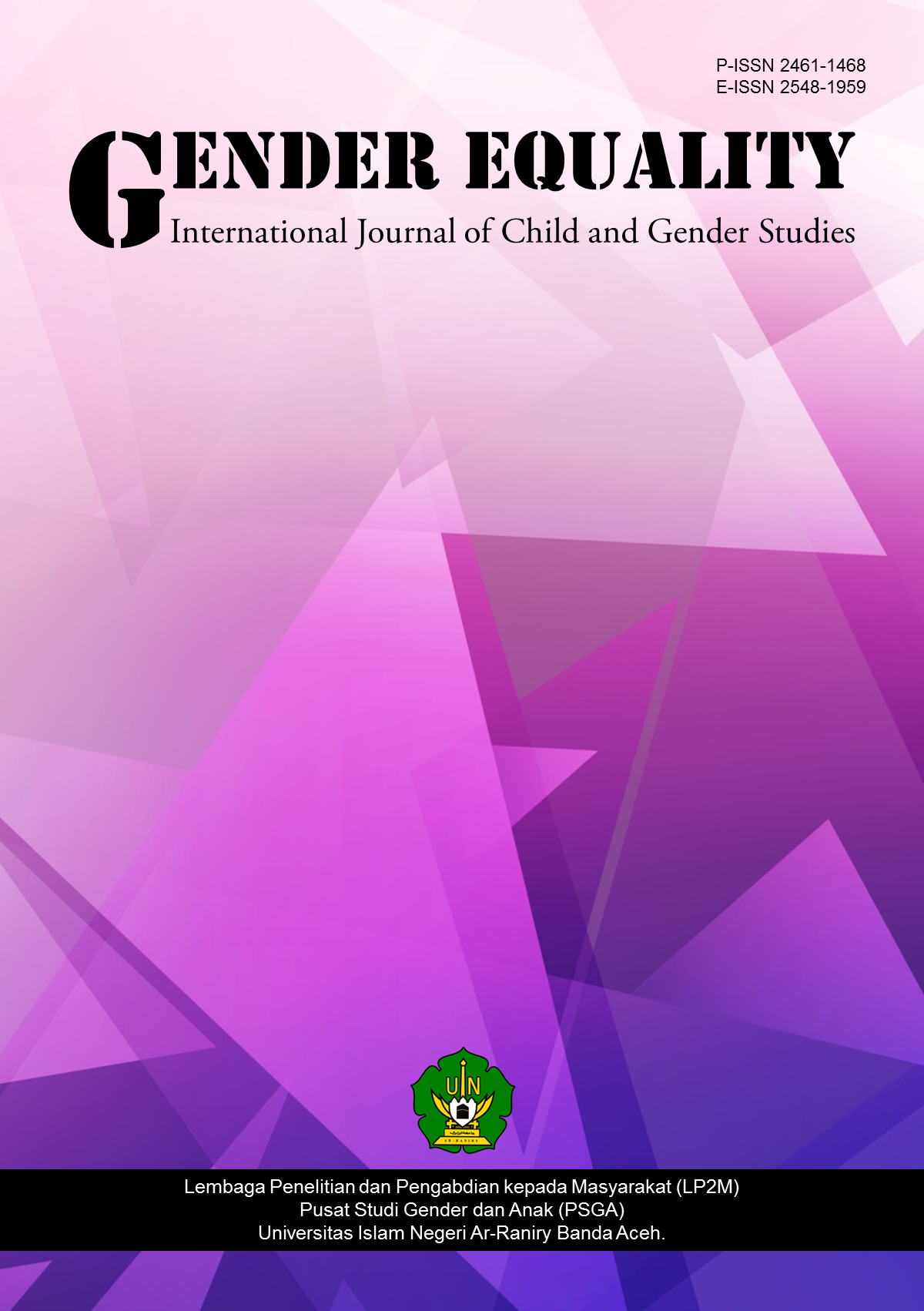The implementation and effectiveness of Indonesian Supreme Court Rule No. 3 of 2017 on women victims of the sexual violence in Yogyakarta
DOI:
https://doi.org/10.22373/equality.v9i2.18069Keywords:
Effectiveness, PERMA No. 3 of 2017, Women, Victims, Sexual ViolenceAbstract
PERMA (Supreme Court Rule) No. 3 of 2017 issued by the Supreme Court regulates the attitude guidelines for judges in adjudicating women's cases in conflict with the law, both criminal and civil cases involving women as victims, witnesses, or parties. These regulations can be used as a legal basis by judges in adjudicating cases of women in conflict with the law due to criminal acts of sexual violence. This research aims to determine the effectiveness of implementing PERMA No. 3 of 2017 concerning guidelines for adjudicating cases of women in conflict with the law as a result of victims of sexual violence at the Yogyakarta District Court. The method used in this research is empirical normative, which focuses on collecting information obtained from judges at the Yogyakarta District Court regarding the effectiveness of PERMA No. 3 of 2017 against women as a result of victims of sexual violence. The approach methods that the author uses in this research include the conceptual approach, the statutory approach, and the case approach. The data collection method is through interviews and documentation of judges, and the data analysis used is descriptive-qualitative. This research concludes that PERMA No. 3 of 2017 has been quite effective in accordance with the theory of legal effectiveness, which uses several a quo decisions as samples to determine whether PERMA No. 3 of 2017 has been applied and implemented in the Yogyakarta District Court for women victims of sexual violence.
References
Ali, Z. (2009). Metode penelitian hukum. Sinar Grafika.
Amilia, F., Tobroni, F., & Faza, M. H. (n.d.). Perlindungan perempuan korban pelecehan seksual berhadapan hukum. Musãwa Jurnal Studi Gender dan Islam, 22(1), 57-71.
Atmaja, I. S., & Alviah, A. (2023). Perlindungan hukum terhadap perempuan korban tindak pidana dalam perundangan Indonesia. Jurnal Hukum, Pendidikan & Sosial Keagamaan, 2(1), 83-94. https://doi.org/https://doi.org/10.47200/awtjhpsa.v1i2.1548
Handayani, A., Widodo, S., & Maulia, D. (2022). Mapping the susceptible areas from violence against women and children. Gender Equality: International Journal of Child and Gender Studies, 8(2), 173-189. https://doi.org/10.22373/equality.v8i2.13646
Ishaq. (2017). Metode penelitian hukum dan penulisan skripsi, tesis, serta disertasi. Bandung: Alabeta.
Jamaludin, A. (2021). Perlindungan hukum anak korban kekerasan seksual. JCIC : Jurnal CIC Lembaga Riset Dan Konsultan Sosial, 3(2), 1–10. https://doi.org/10.51486/jbo.v3i2.68
Juliandi, J., Yasmin, P., & Bungana, R. (2023). Perlindungan hukum terhadap korban pelecehan seksual dilihat dari segi hukum internasional. Jurnal Edukasi Nonformal, 4(1), 43-51. https://ummaspul.e-journal.id/JENFOL/article/view/5688
Khatimah, K. (2017). Fungsi Mahkamah Agung dalam pengawasan hakim terhadap penyelenggaraan peradilan. Jurnal Hukum: Al Hikam, 1(1), 1–14.
Muhaimin. (2020). Metode penelitian hukum (F. Hijriyanti (ed.); First). Mataram University Press.
Paminto, S. R., & Hermawati, K. (2023). Perlindungan korban kekerasan seksual dalam hukum positif indonesia dan hukum internasional berdasarkan Beijing Declaration. Jurnal Dialektika Hukum, 5(1). https://doi.org/https://doi.org/10.36859/jdh.v5i1.1408
Purwanti, A., & Hardiyanti, M. (2018). Strategi penyelesaian tindak kekerasan seksual terhadap perempuan dan anak melalui RUU Kekerasan Seksual. Masalah-Masalah Hukum, 47(2), 138-148. https://doi.org/10.14710/mmh.47.2.2018.138-148
Rafi’ie, M. (2023). Tinjauan yuridis terhadap perbuatan catcalling (Pelecehan seksual secara verbal). Journal Justicia, 12(12), 223–239.
Redi, A. (2018). Hukum pembentukan peraturan perundang-undangan (Tarmidzi (ed.)). Sinar Grafika.
Riyadi, A. G. P., Rahmiaji, L. R., & Ulfa, N. S. (2023). Esensi pengalaman selebgram perempuan sebagai korban pelecehan seksual online. Interaksi Online, Vol 11(3), 597–604.
Siahaan, R. G., Septina, T., Nasution, M. Y., & Siregar, S. A. (2022). Perlindungan hukum terkait tindak pidana kekerasan seksual terhadap perempuan (Studi kasus di Polrestabes Medan). Jurnal Retentum, 4(1), 155–164. https://jurnal.darmaagung.ac.id/index.php/retentum/article/view/2794
Siregar, E., Rakhmawaty, D., & Siregar, Z. A. (2020). Kekerasan seksual terhadap perempuan: Realitas dan hukum. PROGRESIF: Jurnal Hukum, 14(1). https://doi.org/10.33019/progresif.v14i1.1778
Soekanto, S. (2019). Efektivikasi hukum dan peranan sanksi (T. Surjaman (ed.); Anggota IK). Remadja Karya CV. Bandung.
Soekanto, S. (2021). Faktor-faktor yang mempengaruhi penegakan hukum (Rahmatika (ed.); Kharisma P). Raja Grafindo Persada.
Sumera, M. (2013). Perbuatan kekerasan/pelecehan seksual terhadap perempuan. Lex Et Societatis, 1(2), 39–49.
Surayda, H. I. (2017). Perlindungan Hukum Terhadap Korban Kekerasan Seksual Dalam Kajian Hukum Islam. Jurnal Ius Constituendum, 2(1), 24-38. https://doi.org/http://dx.doi.org/10.26623/jic.v2i1.543
Widiartana, D. G. (2014). Viktimologi perspektif korban dalam penanggulangan kejahatan. (Kelompok P). Cahaya Atma Pustaka.
Wulandari, E. P., & Krisnani, H. (2021). Kecenderungan menyalahkan korban (victim-blaming) dalam kekerasan seksual terhadap perempuan sebagai dampak kekeliruan atribusi. Share : Social Work Journal, 10(2), 187-197. https://doi.org/10.24198/share.v10i2.31408
Downloads
Published
Issue
Section
License
GENDER EQUALITY: International Journal of Child and Gender Studies allows the author(s) to hold the copyright and to retain the publishing rights without restrictions. Authors who publish with this journal agree to the following terms:
- Authors retain copyright and grant the journal right of first publication with the work simultaneously licensed under a Creative Commons Attribution License that allows others to share the work with an acknowledgment of the work's authorship and initial publication in this journal.
- Authors are able to enter into separate, additional contractual arrangements for the non-exclusive distribution of the journal's published version of the work (e.g., post it to an institutional repository or publish it in a book), with an acknowledgment of its initial publication in this journal.
- Authors are permitted and encouraged to post their work online (e.g., in institutional repositories or on their website) prior to and during the submission process, as it can lead to productive exchanges, as well as earlier and greater citation of published work.



